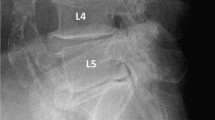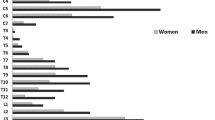Abstract
Background
Compared with Caucasians, East Asians have a lower incident of back pain, lower prevalence and severity of osteoporotic vertebral fracture and lumbar spine degeneration.
Aim
This study compares radiographic spine degeneration features of older Chinese women (as an example of East Asians) and older Italian women (as an example of Caucasians) with a focus on the thoracic spine.
Methods
From two population-based epidemiological studies conducted in Hong Kong, China and Rome, Italy, 297 pairs (mean age: 73.6 years) age-matched older community women’s lateral spine radiographs were sampled. Existence (or absence) of seven degeneration features were assessed including: (1) hyper-kyphosis, (2) disc space narrowing (T3/T4 ~ T11/T12), (3) osteoarthritic (OA) wedging (T4 ~ T12), (4) generalised osteophyte formation (T4 ~ T12); (5) acquired short vertebrae (T4 ~ T12), (6) Schmorl node (T4 – L5), (7) disc calcification (T4–L5).
Results
Italian women were more likely to have hyper-kyphosis (53.4% vs 25.6%), disc space narrowing (34.4% vs. 17.2%), OA wedging (6.4% vs. 0.67%), Schmorl node (19.5% vs. 4.4%, all P < 0.001). However, there was no statistically significant difference in osteophyte formation (7.7% vs. 9.4%, P > 0.1) and acquired short vertebrae (8.0% vs. 10.4%, P > 0.1). Disc calcification was uncommon among both Chinese and Italians.
Discussion and conclusion
For the first time, this study documented a lower prevalence of a number of thoracic spine degeneration features among Chinese. This study further affirms the concept of a generally healthier spine in older Chinese relative to older Caucasians. The observed differences may reflect a foundational background influence of genetic predisposition that represents an important line of future research.


Similar content being viewed by others
Data availability
The data including individual records are not publicly available due to privacy or ethical restrictions. However, data can be shared on reasonable request to the corresponding author.
References
Deyo RA, Mirza SK, Martin BI (2006) Back pain prevalence and visit rates: estimates from U.S. national surveys, 2002. Spine 31:2724–2727. https://doi.org/10.1097/01.brs.0000244618.06877.cd
Mailis-Gagnon A, Yegneswaran B, Nicholson K et al (2007) Ethnocultural and sex characteristics of patients attending a tertiary care pain clinic in Toronto, Ontario. Pain Res Manag 12:100–106. https://doi.org/10.1155/2007/425318
Waterman BR, Belmont PJ Jr, Schoenfeld AJ (2012) Low back pain in the United States: incidence and risk factors for presentation in the emergency setting. Spine J 12:63–70. https://doi.org/10.1016/j.spinee.2011.09.002
Meana M, Cho R, Chronic DM et al (2004) The extra burden on canadian women. BMC Womens Health 4:S17. https://doi.org/10.1186/1472-6874-4-S1-S17
Wáng YXJ, Diacinti D, Leung JCS et al (2021) Much lower prevalence and severity of radiographic osteoporotic vertebral fracture in elderly Hong Kong Chinese women than in age-matched Rome Caucasian women: a cross-sectional study. Arch Osteoporos 16:174. https://doi.org/10.1007/s11657-021-00987-6
Hayhoe RPG, Chan R, Skinner J et al (2021) Fracture incidence and the relevance of dietary and lifestyle factors differ in the United Kingdom and Hong Kong: an international comparison of longitudinal cohort study data. Calcif Tissue Int 109:563–576. https://doi.org/10.1007/s00223-021-00870-z
Wang YX, Deng M, Griffith JF et al (2022) “Healthier Chinese spine”: an update of osteoporotic fractures in men (MrOS) and in women (MsOS) Hong Kong spine radiograph studies. Quant Imaging Med Surg 12:2090–2105. https://doi.org/10.21037/qims-2021-07
Wáng YXJ (2022) The definition of spine bone mineral density (BMD)-classified osteoporosis and the much inflated prevalence of spine osteoporosis in older Chinese women when using the conventional cutpoint T-score of 2.5. Ann Transl Med 10:1421. https://doi.org/10.21037/atm-22-4559
Yoshimura N, Dennison E, Wilman C et al (2000) Epidemiology of chronic disc degeneration and osteoarthritis of the lumbar spine in Britain and Japan: a comparative study. J Rheumatol 27:429–433
So TY, Diacinti D, Leung JCS et al (2022) Lower prevalence and severity of degenerative changes in the lumbar spine in elderly Hong Kong Chinese compared with age-matched Italian Caucasian women. Spine 47:1710–1718. https://doi.org/10.1097/BRS.0000000000004445
Wáng YXJ, Diacinti D, Griffith JF et al (2022) Lumbar L3 marrow fat content in older Italian women is not apparently higher than in older Chinese women. Ann Transl Med 10:648. https://doi.org/10.21037/atm-22-808
Brasiliense LB, Lazaro BC, Reyes PM et al (2011) Biomechanical contribution of the rib cage to thoracic stability. Spine 36:E1686–E1693. https://doi.org/10.1097/BRS.0b013e318219ce84
Andriacchi T, Schultz A, Belytschko T et al (1974) A model for studies of mechanical interactions between the human spine and rib cage. J Biomech 7:497–507. https://doi.org/10.1016/0021-9290(74)90084-0
Okada E, Daimon K, Fujiwara H et al (2019) Ten-year longitudinal follow-up MRI study of age-related changes in thoracic intervertebral discs in asymptomatic subjects. Spine 44:E1317–E1324. https://doi.org/10.1097/BRS.0000000000003145
Matsumoto M, Okada E, Ichihara D et al (2010) Age-related changes of thoracic and cervical intervertebral discs in asymptomatic subjects. Spine 35:1359–1364. https://doi.org/10.1097/BRS.0b013e3181c17067
Kramer PA (2006) Prevalence and distribution of spinal osteoarthritis in women. Spine 31:2843–2848. https://doi.org/10.1097/01.brs.0000245854.53001.4e
Park MS, Moon SH, Kim TH et al (2015) Asymptomatic stenosis in the cervical and thoracic spines of patients with symptomatic lumbar stenosis. Global Spine J 5:366–371. https://doi.org/10.1055/s-0035-1549031
Abdel-Hamid Osman A, Bassiouni H, Koutri R et al (1994) Aging of the thoracic spine: distinction between wedging in osteoarthritis and fracture in osteoporosis–a cross-sectional and longitudinal study. Bone 15:437–442. https://doi.org/10.1016/8756-3282(94)90822-2
Ma JB, Wáng YXJ (2022) Chest radiograph prevalence of vertebral deformity among young and middle-aged population of mixed city dwellers and rural residents. J Thorac Dis 14:4685–4698. https://doi.org/10.21037/jtd-22-1386
Wáng YXJ, Lu ZH, Leung JCS et al (2023) Osteoporotic-like vertebral fracture with less than 20% height loss is associated with increased further vertebral fracture risk in older women: the MrOS and MsOS (Hong Kong) year-18 follow-up radiograph results. Quant Imaging Med Surg 13:1115–1125. https://doi.org/10.21037/qims-2022-06
Du EZ, Wáng YXJ (2022) CT detects more osteoporotic endplate depressions than radiograph: a descriptive comparison of 76 vertebrae. Osteoporos Int 33:1569–1577. https://doi.org/10.1007/s00198-022-06391-1
Azzouzi H, Ichchou L (2022) Schmorl’s nodes: demystification road of endplate defects-a critical review. Spine Deform 10:489–499. https://doi.org/10.1007/s43390-021-00445-w
Wáng YXJ (2023) Schmorl’s node of primarily developmental cause and Schmorl’s node of primarily acquired cause: two related yet different entities. Quant Imaging Med Surg. https://doi.org/10.21037/qims-23-252
Kwok AW, Gong JS, Wang YX et al (2013) Prevalence and risk factors of radiographic vertebral fractures in elderly Chinese men and women: results of Mr. OS (Hong Kong) and Ms. OS (Hong Kong) studies. Osteoporos Int 24:877–885. https://doi.org/10.1007/s00198-012-2040-8
Wáng YXJ, Che-Nordin N, Deng M et al (2019) Osteoporotic vertebral deformity with endplate/cortex fracture is associated with higher further vertebral fracture risk: the Ms. OS (Hong Kong) study results. Osteoporos Int 30:897–905. https://doi.org/10.1007/s00198-019-04856-4
Wáng YXJ, Diacinti D, Leung JCS et al (2022) Further evidence supports a much lower prevalence of radiographic osteoporotic vertebral fracture in Hong Kong Chinese women than in Italian Caucasian women. Arch Osteoporos 17:13. https://doi.org/10.1007/s11657-021-01056-8
Wáng YXJ (2023) A summary of our recent evidence-based works on radiographic diagnostics of prevalent osteoporotic vertebral fracture in older men and women. Quant Imaging Med Surg 13:1264–1285. https://doi.org/10.21037/qims-22-1411
Che-Nordin N, Deng M, Griffith JF et al (2018) Prevalent osteoporotic vertebral fractures more likely involve the upper endplate than the lower endplate and even more so in males. Ann Transl Med 6:442. https://doi.org/10.21037/atm.2018.10.61
Koelé MC, Lems WF, Willems HC (2020) The clinical relevance of hyperkyphosis: a narrative review. Front Endocrinol (Lausanne) 11:5. https://doi.org/10.3389/fendo.2020.00005
Ensrud KE, Black DM, Harris F et al (1997) Correlates of kyphosis in older women. The fracture intervention trial research group. J Am Geriatr Soc 45:682–687. https://doi.org/10.1111/j.1532-5415.1997.tb01470.x
Harrison RA, Siminoski K, Vethanayagam D et al (2007) Osteoporosis related kyphosis and impairments in pulmonary function: a systematic review. J Bone Miner Res 22:447–457. https://doi.org/10.1359/jbmr.061202
Kado DM, Huang MH, Nguyen CB et al (2007) Hyperkyphotic posture and risk of injurious falls in older persons: the Rancho Bernardo Study. J Gerontol Series A Biol Sci Med Sci 62:652–657. https://doi.org/10.1093/gerona/62.6.652
Fletcher JG, Stringer MD, Briggs CA et al (2015) CT morphometry of adult thoracic intervertebral discs. Eur Spine J 24:2321–2329. https://doi.org/10.1007/s00586-015-3925-y
Wáng YXJ, Xiao BH (2022) Estimations of bone mineral density defined osteoporosis prevalence and cutpoint T-score for defining osteoporosis among older Chinese population: a framework based on relative fragility fracture risks. Quant Imaging Med Surg 12:4346–4360. https://doi.org/10.21037/qims-22-281
Zehra U, Tryfonidou M, Iatridis JC et al (2022) Mechanisms and clinical implications of intervertebral disc calcification. Nat Rev Rheumatol 18:352–362. https://doi.org/10.1038/s41584-022-00783-7
Zehra U, Bow C, Cheung JPY et al (2018) The association of lumbar intervertebral disc calcification on plain radiographs with the UTE Disc Sign on MRI. Eur Spine J 27:1049–1057. https://doi.org/10.1007/s00586-017-5312-3
Livshits G, Popham M, Malkin I et al (2011) Lumbar disc degeneration and genetic factors are the main risk factors for low back pain in women: the UK Twin Spine Study. Ann Rheum Dis 70:1740–1745. https://doi.org/10.1136/ard.2010.137836
Rajasekaran S, Kanna RM, Reddy RR et al (2016) How reliable are the reported genetic associations in disc degeneration?: The influence of phenotypes, age, population size, and inclusion sequence in 809 patients. Spine 41:1649–1660. https://doi.org/10.1097/BRS.0000000000001847
Mäkitie RE, Niinimäki T, Nieminen MT et al (2017) Impaired WNT signaling and the spine-Heterozygous WNT1 mutation causes severe age-related spinal pathology. Bone 101:3–9. https://doi.org/10.1016/j.bone.2017.04.001
Williams FM, Manek NJ, Sambrook PN et al (2007) Schmorl’s nodes: common, highly heritable, and related to lumbar disc disease. Arthritis Rheum 57:855–860. https://doi.org/10.1002/art.22789
Cong E, Walker MD (2014) The Chinese skeleton: insights into microstructure that help to explain the epidemiology of fracture. Bone Res 2:14009. https://doi.org/10.1038/boneres.2014.9
Liuke M, Solovieva S, Lamminen A et al (2005) Disc degeneration of the lumbar spine in relation to overweight. Int J Obes (Lond) 29:903–908. https://doi.org/10.1038/sj.ijo.0802974
Wang YX, Griffith JF (2010) Effect of menopause on lumbar disk degeneration: potential etiology. Radiology 257:318–320. https://doi.org/10.1148/radiol.10100775
Wang YX (2018) Senile osteoporosis is associated with disc degeneration. Quant Imaging Med Surg 8:551–556. https://doi.org/10.21037/qims.2018.07.04
Italy Smoking Rate 2007–2023, online at <https://www.macrotrends.net/countries/ITA/italy/smoking-rate-statistics> accessed April 21, 2023
Qin P, Wang T, Luo Y (2022) A review on plant-based proteins from soybean: Health benefits and soy product development. J Agricult Food Res 7:100265. https://doi.org/10.1016/j.jafr.2021.100265
Wáng YXJ (2022) Fragility fracture prevalence among elderly Chinese is no more than half of that of elderly Caucasians. Quant Imaging Med Surg 12:874–881. https://doi.org/10.21037/qims-21-876
Funding
Nil.
Author information
Authors and Affiliations
Contributions
All authors confirm that the manuscript has been read and approved by all the authors, that the requirements for authorship have been met, and that each author believes that the manuscript represents honest work.
Corresponding authors
Ethics declarations
Conflict of interest
Nil.
Ethics approval and consent to participate
The study protocol was approved by the institutional Ethics Committees of the authors’ institutions.
Consent for publication
All authors consent to the publication of the manuscript in Aging Clinical and Experimental Research, should the article be accepted by the Editor-in-chief upon completion of the refereeing process.
Informed consent
Informed consent was obtained from all individual participants included in the study.
Additional information
Publisher's Note
Springer Nature remains neutral with regard to jurisdictional claims in published maps and institutional affiliations.
Supplementary Information
Below is the link to the electronic supplementary material.
Rights and permissions
Springer Nature or its licensor (e.g. a society or other partner) holds exclusive rights to this article under a publishing agreement with the author(s) or other rightsholder(s); author self-archiving of the accepted manuscript version of this article is solely governed by the terms of such publishing agreement and applicable law.
About this article
Cite this article
Wáng, Y.X.J., Diacinti, D., Iannacone, A. et al. A comparison of radiographic degeneration features of older Chinese women and older Italian Caucasian women with a focus on thoracic spine. Aging Clin Exp Res 35, 2583–2591 (2023). https://doi.org/10.1007/s40520-023-02537-1
Received:
Accepted:
Published:
Issue Date:
DOI: https://doi.org/10.1007/s40520-023-02537-1




